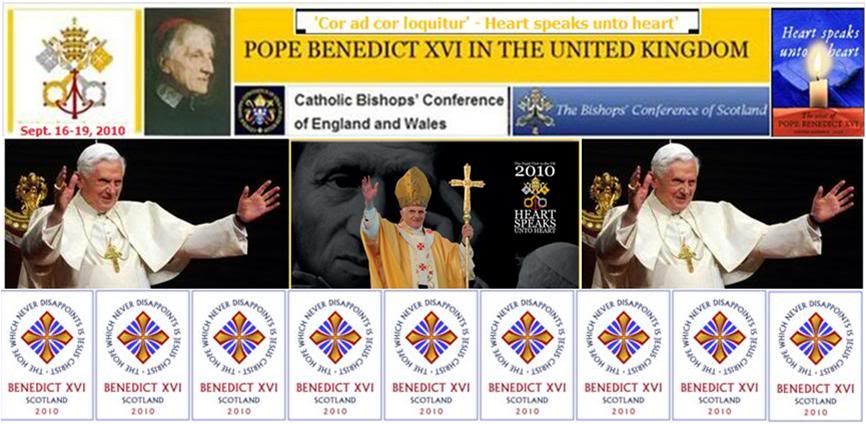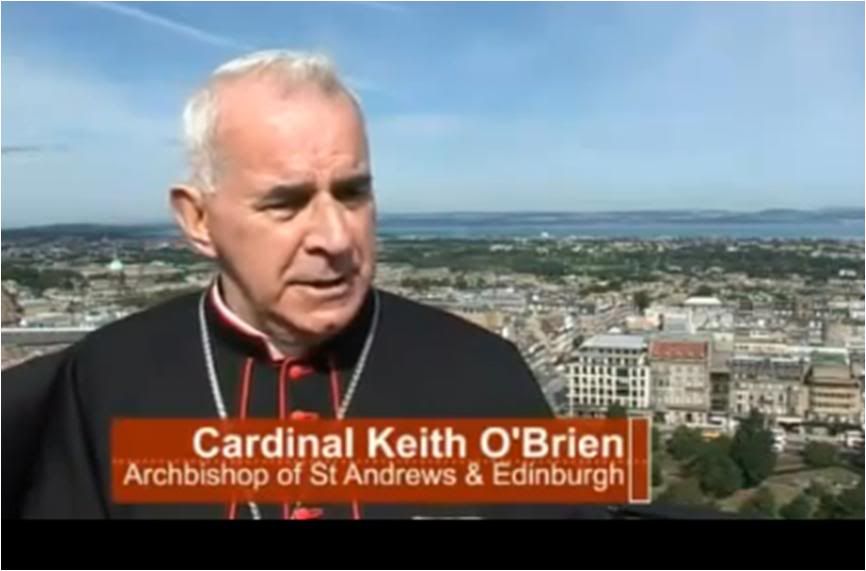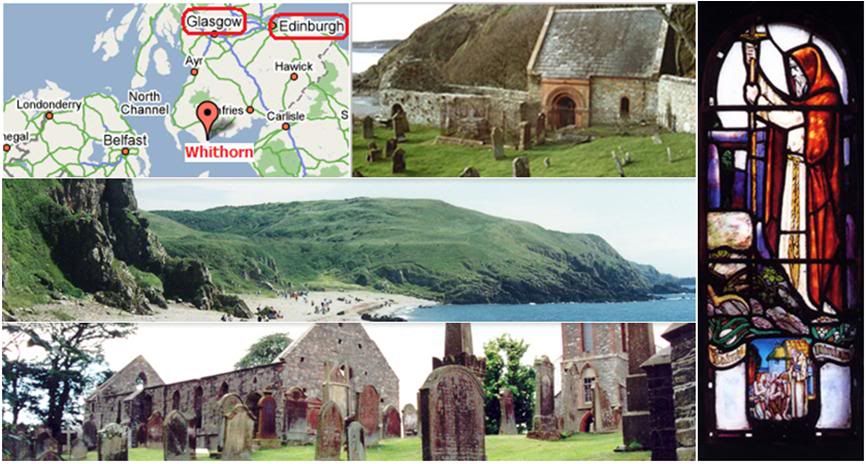 Saint Ninian's land
Saint Ninian's land
awaits Benedict XVI
by Cardinal Keith Michael Patrick O'Brien
Archbishop of Saint Andrews and Edinburgh
President of the Scottish Bishops' Conference
Translated from the 9/8/10 issue of


Benedict XVI will arrive in Edinburgh on Sept. 16 for a four-day visit in the United Kingdom. The capital of Scotland is also the seat of the Archbishop of St. Andrews and Edinburgh which will welcome the Pope.
Immediately upon arrival, the Pope will be taken to the royal palace of Holyrood House, where he will have a historic meeting with Her Majesty, Queen Elizabeth, some members of Government, Parliamentarians and other authorities from Scotland, England, Wales and North Ireland.
The Catholics of Scotland are proud to welcome the Pontiff at the start of his visit, on the Feast of St. Ninian of Galloway, apostle of Scotland. Tradition narrates that Ninian travelled from Rome where he had been ordained bishop and arrived in Scotland more than 1500 years ago, in 397.
 Right, figure of St. Ninian, from a stained-glass window, Edinburgh Castle.
Right, figure of St. Ninian, from a stained-glass window, Edinburgh Castle.
He founded a small Christian community at a point in the extreme south of Scotland which he called White House, now known as Whithorn from its dialect corruption. It is considered the first Scottish city and one of the first colonies of the nation.
Although the tight program will not allow a visit to Whithorn by Benedict XVI, St. Ninian will nonetheless be present in the course of the day. While the Pope is in Holyrood Palace, a parade will be going on in the center of Edinburgh to celebrate St. Ninian's Day, with the participation of schoolchildren from all over Scotland.
There will be a historical theatrical show in the open, which will relive important moments in the development of the territory now known as Scotland, and the cultural Scottish patrimony will be celebrated with traditional bagpipe music.
After saying farewell to Queen Elizabeth, Benedict XVI will travel through the center of Edinburgh in the Popemobile where he will be feted by the schoolchildren and other people assembled to watch the historical reenactments.
After lunch and a midday rest, Benedict XVI will then head for Glasgow. Once again, he will pass through crowds in the Popemobile all the way to Bellahouston Park, where he will celebrate Mass for more than 100,000 persons, but which will be seen my millions around the world through TV and the Internet. The choirs will consist of hundreds of singers, along with the accompanists.
We await eagerly the words of the Holy Father in his homily. In view of his recent decision to establish a Pontifical Council for the Promotion of New Evangelization, the words that he will address to the Scottish people take on a particular value.
We live in a land where the seeds of the Gospel were first sown more than 1500 years ago. They made of it a land of saints and scholars, famous for giving birth to missionaries like Columban, and holy men adn women like Margaret, Queen of Scotland, and scholars like John Duns Scotus; and for being the site of renowned monastic communities like Border Abbey, and famous centers of instruction developed thanks to the establishment by the Church of great universities in the late Middle Ages.
A great rupture with the past took place in the 16th century because of the Protestant Reformation, when almost all of the population of the mainland and many of the islands gradually abandoned the Catholic faith of their ancestors to embrace Presbyterianism.
Celebration of the Mass was prohibited, and priests were persecuted and expelled. A famous case was that of the Jesuit priest John Ogilvie, who was arrested while he was saying Mass for the tiny Catholic community in Glasgow. He was imprisoned and convicted in 1615. In 1976, he was canonized by Paul VI.
From the death of John Ogilvie to the arrival of Catholic immigrants from Ireland in the 19th century, there were practically no Catholics left in the cities and principal towns of Scotland. But gradually, a Catholic population started to re-establish itself. Most of them were still poor and uneducated. The need to teach the children of the Catholic immigrants was deeply felt, and as the Catholic population grew, so too did the number of priests, and of religious men and women who arrived to take care of the children's education.
Catholic instruction was provided alongside that provided by regular schools inspired by the Presbyterian ethic. But notwithstanding the quality of instruction they received, young Catholics found it practically impossible to have access to university education and to the professions.
Encouraged and sustained by the perseverance of priests, brothers, and, to a very significant degree, of female religious organizations, the small but growing community continued to believe in the value of education. Thus, with farsightedness and many sacrifices, every effort was made so that children could attend Catholic schools.
A small number of the enlightened members of society sustained these efforts from the beginning, such that the Catholic school system could grow and develop parallel to that of the government, until in 1918, the government agreed to take over the financial and administrative responsibilities for the Catholic schools, while allowing the Church to maintain school direction, thus assuring -within the state sector - the Catholic management and identity of Catholic schools, up to the present.
The Catholic population in Scotland continued to grow during the second half of the 19th century and the first half of the 20th. In addition to those who came from Ireland, there were those who came from Italy, and from central and eastern Europe.
In the 20th century, Catholics contributed even more to the entire Scottish society, in the workplace and in the professions. They have continued to have strong links to other Catholic communities, especially with Ireland, where many priests serving the Church in Scotland have their roots. There are Scottish Catholics in Canada where, in the diocese of Antigonish (whose patron saint is St. Ninian), descendants of Scottish immigrants still speak Gaelic.
Other links can be found in Australia, and it is with great joy and pride that the Scottish Catholics, especially those from the Diocese of Argyll and The Isles, are looking forward to the canonization of Blessed Mary McKillop, whose parents emigrated from Scotland to Australia in the 19th century.
In 1982, John Paul II visited Scotland and left a lasting memory not only for Catholics but even in the greater Christian community and all of Scottish society.
He encouraged the Catholic Church in Scotland to have a decisive role in the life of the nation, and especially, to move forward in the ecumenical dialog with our Christian brothers and sisters.
Today in 2010, we await Benedict XVI's visit with great anticipation while we look to the future with certainty. In recent years, the Catholic community has become richer, thanks to a new wave of immigration from central and eastern Europe, particularly from Poland, and from southern India.
The need for dialog among religions has become much more urgent than it was 30 years ago. We trust that the voice of the Pope will be heard by our brothers and sisters in Christ, by people of other religions, and by all men of good will.
For our part, as Catholics we can be sure that he will confirm us in the faith and that he will give us the encouragement and the support that we need to face the challenges of the present, and to continue bearing witness to Christ who is the way, the truth and the life.
What Cardinal O'Brien does not say is that it was his idea to stage a St. Ninian's Day parade to welcome the Pope, an idea welcomed by the City Council of Edinburgh which has even put up a website for it:

The St Ninian's Day Parade will mark the historic occasion of Pope Benedict XVI’s state visit to Scotland and celebrates the first man to be named a Saint in Scotland, nearly 1600 years ago.
Spectators are invited to watch the parade and welcome Pope Benedict XVI to Scotland.

The parade will start at 11:00am from Regent Road and march along Princes Street. This is a free event and spectators are advised to arrive in plenty of time.
To this day Ninian is a saint held in common by all Scottish Christians and, indeed, by all Scots. That's why the Archbishop of St Andrews and Edinburgh, Cardinal Keith Patrick O'Brien, asked the question earlier this year - "Why don't we resurrect the great festivities that used to surround St Ninian's Day in this country? A grand Scottish spectacle to welcome Benedict XVI."
He wanted an event that is:
*Joyous - creating a truly memorable day for all who attend.
•Charitable - raising money for good causes, both at home and abroad.
•Inclusive - welcoming to everybody regardless of religion.
The result is the St Ninian's Day Parade! Up to a billion people around the world will be watching. Be part of it! You're very welcome. See you in Edinburgh on the 16th of September!
The parade will feature pipers and drummers from Scotland and further afield, who will lead the parade from Regent Road and along Princes Street. Pipe Bands will play 'Highland Cathedral' as Pope Benedict XVI travels past.
Our VIP’s will be nearly 1000 school pupils from St Ninian Schools around Scotland who will help turn Princes Street into a sea of blue. To add to the colour thousands of flags that will be given out to spectators along the route.
Over the last 1,600 years Scotland has had a remarkable history and the St Ninian’s Parade will also be a fantastic opportunity for spectators and the media to meet and greet important characters from Scotland's past, including William Wallace, Robert the Bruce, Mary Queen of Scots, John Knox and Robert Burns and of course, St Ninian himself.
As the World media focus on Scotland we want to bring to Scotland’s remarkable history to life and offer a huge welcome to everyone who would like to enjoy the St Ninian’s Day Parade which will take place on the 16 September.
Said Councillor Jenny Dawe, leader of the Edinburgh City Council:
“This is a superb opportunity for Edinburgh to be seen on the world stage and to showcase the city as an excellent host of major events. While many people overseas already appreciate Edinburgh’s qualities as a place in which to work, study and holiday, I hope that some of the millions watching the Pope’s arrival in the UK are encouraged to come and see our city for themselves. It is undoubtedly a significant visit and I’m sure that the city will, as usual, rise to the occasion."

[Modificato da TERESA BENEDETTA 08/09/2010 08:58]